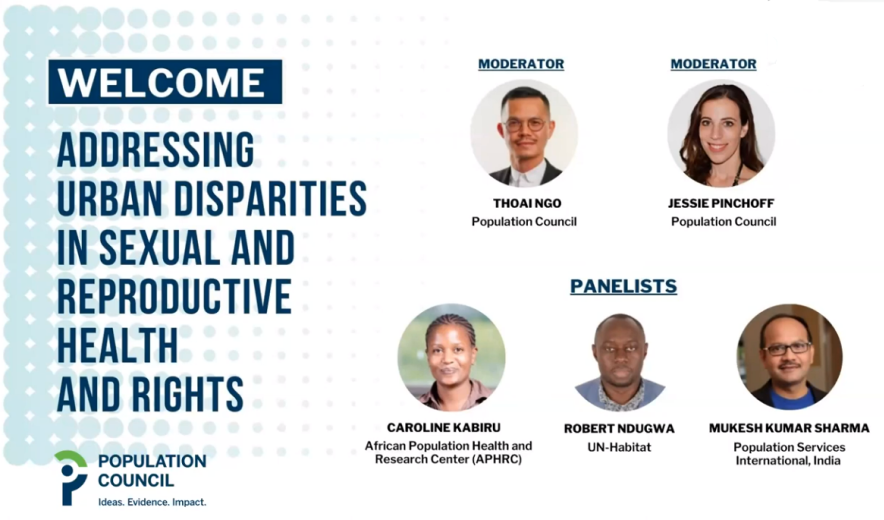
While SDG 5 calls for gender equality and empowerment and SDG 11 explicitly refers to building inclusive, safe, sustainable, and resilient cities, addressing SRHR in urban settings will help to achieve priorities across many other closely linked SDGs. At a seminar hosted by the Population Council, experts from the African Population and Health Research Center (APHRC), PSI-India, and UN-HABITAT discussed their work on urban SRHR. Caroline Kabiru, Mukesh Kumar Sharma, and Robert Ndugwa joined our panel which was moderated by Thoai Ngo and Jessie Pinchoff. The group discussed current research, critical data and measurement gaps, and recommendations and future directions for research, programming, and policies. Here is a summary of the research and perspectives shared.
The current evidence base largely does not link features of urban environment to SRHR outcomes.
Latest findings suggest that the current evidence base lacks robust discussion of how features within urban environments and other structural factors—especially social and economic inequality—contribute to and reinforce cycles of poor SRHR outcomes.
Urban populations and adolescents in particular, face distinct barriers in accessing SRHR services due to concentrated poverty, exclusion and marginalization, and physical aspects of the urban environment. Women and girls also face gender-specific challenges: safety, income inequality, and inequitable gender norms.
Understanding such barriers and targeting interventions appropriately is critical to supporting program implementation at scale. Although there is a steady growth in research on adolescent SRHR in urban slums, the geographic and methodological scope of the literature is limited; there are few multisite and qualitative/mixed methods studies.
Significant disparities exist within urban contexts related to accessing education, transportation, open public spaces, water and sanitation, yet limited research focuses on intra-urban inequities. More evaluations of interventions to improve SRHR of urban residents are also needed.
Some promising evidence exists on facility-based interventions and provider training programs; examples are the Urban Reproductive Health Initiative (URHI) and holistic programs aimed at addressing the root causes of SRHR in adolescents including Biruh Tesfa and AGI-K.
However we need longitudinal studies to understand pathways, qualitative studies contextualizing norms and societal factors, research on intra-urban slum inequalities, and studies that measure the effectiveness of interventions.
There are significant geographic inequities in research prioritization and data availability.
Most studies on SRHR in urban contexts focus on Kenya, India, and Nigeria—countries where stakeholders in the development sector have made major investments. The Urbanization Projection Model developed by the Population Council’s initiative on Population, Environmental Risks, and the Climate Crisis (PERCC) projects changes in the proportion of the population living in urban areas to model trajectories of urban growth for regions at global, national, and subnational levels.
By 2050 some of the world’s largest mega cities will be in Bangladesh, Democratic Republic of Congo, Egypt, and Mexico, among others. These diverse and rapidly growing urban centers must be prioritized in the geographic scope of future research as they will present distinct challenges to achieving equitable SRHR for all.
Data and measurement inconsistencies create challenges in assessing risks and needs of urban communities.
Gaps in uniformly categorizing urban areas and key aspects of the urban environment make it challenging to understand the heterogeneity of urban environments, populations, and SRHR outcomes. Without this consistency, comparisons across studies to identify what works are difficult to assess.
Efforts to improve the level of detail of the data—including on the most marginalized and sometimes difficult-to-reach populations—that are available to policymakers are needed. Standardized data can facilitate intra-urban comparisons, allowing for the development of more contextualized interventions to improve SRHR outcomes, and address structural determinants of health.
We must promote multidisciplinary collaborations in order to develop equitable and inclusive urban health policy.
The New Urban Agenda and SDGs combined require monitoring across many urban-related dimensions—including urban governance and legislation, environmental sustainability, equity and social inclusion, quality of life, productivity, and infrastructure development. Urban policies and regional development plans that respond to the current urbanization challenges are critical to achieving responsible and sustainable urban development.
As most of the world’s population will urbanize in the coming decades, multidisciplinary work to understand urban SRHR access and needs can improve data detail and disaggregation. The collaborations can help develop effective and sustainable policies and interventions that leverage the urban environment to address SRHR disparities and improve outcomes.
Such inclusive urbanization strategies can proactively address inequities across intersecting economic, social, and environmental factors driving poor SRHR outcomes in urban settings. The path forward must ensure that no one is excluded from urban economic growth and global health gains.
Watch “Addressing Urban Disparities in Sexual and Reproductive Health and Rights”
